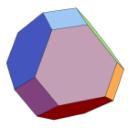Yahoo Answers is shutting down on May 4th, 2021 (Eastern Time) and beginning April 20th, 2021 (Eastern Time) the Yahoo Answers website will be in read-only mode. There will be no changes to other Yahoo properties or services, or your Yahoo account. You can find more information about the Yahoo Answers shutdown and how to download your data on this help page.
Trending News
Implicit differentiation - geometric form of solution?
Let dy/dx satisfy (x² - 1)(dy/dx)² - 2 x y (dy/dx) + y² - 1 = 0
Demonstrate that y(x) has one of two forms, either linear or quadratic; in each case specify its geometric interpretation.
This is quite a pretty problem. I want to see if Answers aficionados get the same answer as me.
2 Answers
- Zo MaarLv 51 decade agoFavorite Answer
Written in differentials, this equation takes the form,
(x dy - y dx)^2 = (dy)^2 + (dx)^2,
or, in polar coordinates, where x = r cos φ and y = r sin φ,
r^4 (d φ)^2 = r^2 (d φ)^2 + (d r)^2,
Eq.(1): r √(r^2-1) d φ = d r.
The first solution is r = 1. If r>1, we can integrate this equation to get φ(r).
The easier way is to notice that the equation of a straight line in the polar coordinates is
x = r cos φ = h.
Here, the x-axis is directed normally to the line, and h is the distance from the coordinate origin to the line.
Differentiating this relation gives
cos φ d r - r sin φ d φ = 0.
Substituting here cos φ = h/r and sin φ = √ (1 - h^2/r^2), we get
Eq.(2): r √(r^2-h^2) d φ = h d r.
Equation (2) coincides with equation (1) if h=1.
Thus, the curves representing solutions of the equation are:
(A) the unit circle,
(B) straight lines tangent to the unit circle.
- DsquaredLv 41 decade ago
For |x| > 1:
Write y = Y(x)*sqrt(x² - 1)
==> dy/dx = {dY/dx + x/(x^2-1)}*sqrt(x² - 1)
-->
dY/dx = +/- sqrt(Y^2+1)/(x^2-1).
The variables can be separated and terms integrated to:
log(Y + sqrt(1+Y^2)) = +/-(1/2)*log(C*|x-1|/|x+1|),
where C is any positive constant.
This can be solved for Y, and consequently,
y = Ax -/+ sqrt(A^2+1), ---- (*)
where A is any real constant.
So for |x| > 1, we have a linear form for y.
For |x| < 1:
write y = Z(x) * sqrt(1-x^2).
Similar working reveals that:
dZ/dx = +/- sqrt(Z^2-1)/(1-x^2).
As for Y, we can find a solution for Z which leads to a linear form for y:
--->
y = Bx +/- sqrt(B^2+1), --- (†)
where B is any real constant.
As an extra however, Z = +/-1 is a solution,
i.e. y = +/-(1-x^2)^(1/2). --- (‡)
Re. geometric interpretation of solutions:
(A) Clearly, (‡) represents the circumference of the unit disc.
(B) The other solutions have the general form:
y = ax +/- sqrt(a^2+1), for any real number a, with restrictions on x,
so these are parts of straight lines in the x-y axis.
If t := x^2 + y^2 (square of distance from line to origin at point(x,y)), then:
t = (a^2+1)*(x^2+1) +/- 2*a*sqrt(a^2+1)*x,
and a bit of calculus shows that
min. value of t is achieved at (x,y) = -/+(a/sqrt(a^2+1),-1/sqrt(a^2+1)),
with t =1.
This confirms Zo Maar's observation that these lines are tangents to the unit circle (since t > 1, except at the single minimum point).



